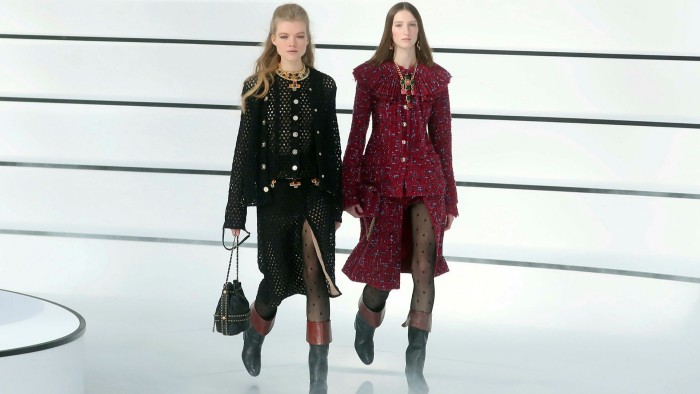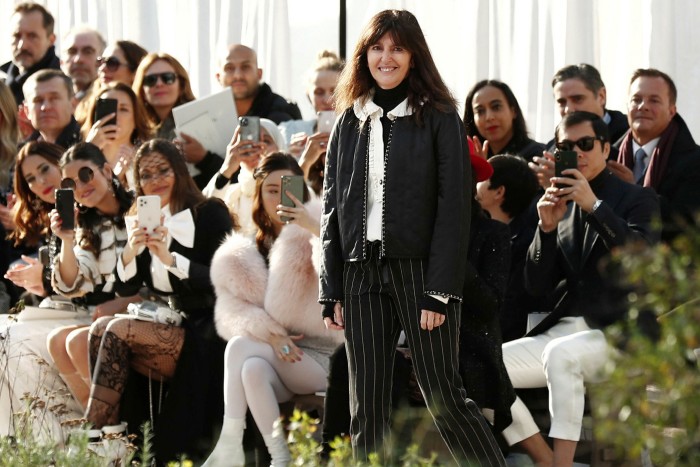Chanel forecasts ‘difficult’ two years for luxury amid Covid-19

Roula Khalaf, Editor of the FT, selects her favourite stories in this weekly newsletter.
Chanel, the French fashion house known for its No 5 perfume and quilted leather handbags, has warned that Covid-19 will weigh on the luxury goods sector for the next two years but signalled it would hold firm on its strategy of avoiding discounting and online selling.
“We expect Covid-19 will lead to significant reduction in revenue and profit in 2020 and that the next 18 to 24 months will be difficult for the sector,” said Philippe Blondiaux, chief financial officer, in an interview.
About 85 per cent of Chanel’s 417 boutiques have reopened, although some in the US, Russia and Latin America remain closed because of quarantine measures.
The privately held company controlled by the billionaire Wertheimer family published annual results on Thursday that showed strong growth last year, its first without longtime designer Karl Lagerfeld at the helm.
The company, founded by Coco Chanel in 1910 in Paris, posted revenue of $12.3bn last year, accelerating to 13 per cent growth on a comparable basis from 10.5 per in 2018. Operating profit rose 16.6 per cent to $3.5bn.
That cements the brand’s position in luxury’s elite, making it the second-biggest behind LVMH’s Louis Vuitton that had $12.9bn in sales in 2019, according to Bernstein estimates, and ahead of Kering’s Gucci with $10.7bn.
Sales of ready-to-wear clothing rose 28 per cent last year, said Mr Blondiaux, and the transition to new designer Virginie Viard’s tenure had been “very smooth”. The brand has charted a quieter course lately, with Ms Viard giving few interviews and holding more austere fashion shows.
“Virginie worked with Karl for decades and knew all the codes of Chanel,” the CFO added. “She is gradually imposing her own style on the collections and on the decor of our fashion shows. Frankly, I think we have not seen any impact on the clientele of the house.”
Asia was Chanel’s biggest region again for the second consecutive year, bringing in 44 per cent of revenue versus 37 per cent for Europe and 19 per cent for the Americas.

The Covid-19 crisis is expected to hit demand for luxury goods hard, especially among Chinese consumers, who have driven the vast majority of growth in recent years. With travel flows expected to be slow for some time yet, sales in duty-free outlets in airports, which bring in roughly one-fifth of sector revenue and an outsized chunk of profit, are also expected to fall sharply.
As a result, HSBC has forecast luxury goods sales to fall 17 per cent this year, while Bain has predicted a decline of up to 35 per cent. Analysts forecast it will take until 2022 or 2023 to return to the €281bn of sales achieved last year.
Nevertheless, Chanel is not planning on major changes to its strategy or retail footprint to cope with the new reality, said Mr Blondiaux.
It does not plan to begin selling its clothing, handbags or watches online despite competitors such as Gucci and Louis Vuitton ramping up their own ecommerce activity. The brand does sell its perfumes and beauty products on Chanel.com though, as well as through Alibaba’s T-Mall in China, and said online revenue climbed 100 per cent in April and May.
“We remain convinced that in-person relationship between fashion adviser and client will remain central to the luxury experience,” said Mr Blondiaux.
Nor will Chanel discount products to clear inventory after lockdowns, even though analysts have predicted steep markdowns. “We adjusted our orders from suppliers at a relatively early stage, so we do not anticipate a problem,” said Mr Blondiaux. “Discounting or destroying inventory has never been in the Chanel philosophy.”
In fact, he added, Chanel increased prices by 4 to 15 per cent in April on some of its products in an effort to keep pricing consistent across regions.
Comments